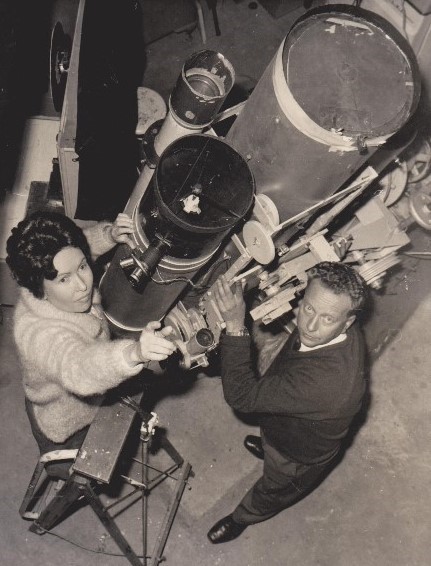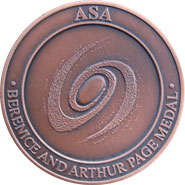
Berenice and Arthur Page Medal
The Berenice Page Medal was inaugurated by the ASA in 1972 in memory of Mrs Berenice Page, an exceptional amateur astronomer and foundation member of the Society. Although most ASA members are professional astronomers, Berenice and her husband Arthur, were readily accepted into the Society because of the indispensable part they played in the IAU Flare Star Programme in the 1960’s.
Arthur Page remained an ASA member until his death in 2011 and, with his family’s agreement, the Society renamed the medal as the Berenice and Arthur Page Medal.

The Berenice and Arthur Page Medal is presented at the biennial National Australian Convention of Amateur Astronomers (NACAA ) by a representative of the ASA Council. The winner also receives free Honorary Associate membership of the ASA
Nominations for the 2026 Berenice and Arthur Page Medal will open October 2025, with a closing date of end-November 2025.

Eligibility
- must be an amateur astronomer, defined as someone who does not use the field of astronomy as their primary source of income and does not have a professional degree or advanced academic training in astronomy.
- must have made scientific contributions that have served to advance astronomy. It is recognised that the amateur astronomical community benefits greatly from members’ organisational services, their popularisation of astronomy and their proficiency in established astronomical techniques, but these qualities are not relevant to the award’s criteria.
Previous winners of the Berenice and Arthur Page Medal are not eligible for nomination.
Nominations
- self-nominations and team nominations are acceptable.
- a letter of nomination that describes the nominee’s achievements, outlining as succinctly as possible the scientific results that the nominee has produced and the subsequent impact on astronomy.
- a covering letter providing contact details for the nominee and a brief summary of their association with astronomy and particular research interests.
- supporting material such as copies of papers, articles or books written by the nominee that substantiate their nomination.
Nominations should be emailed to the ASA Prizes and Awards Coordinator Dr Tanya Hill – thill@museum.vic.gov.au.
Further information can be found in the Conditions and Guidelines.
An assessment committee nominated by the ASA Council will evaluate the submitted materials and make a recommendation to the ASA Council. The decision of the ASA Council is final, including the decision not to award a prize in any given year.
Limited travel funds to support attendance at the award presentation during the National Australian Convention of Amateur Astronomers may be made available at the discretion of the ASA Council.
Previous Winners
- 2024 – Mr Rod Stubbings
- For 400,000 variable star observations, specifically cataclysmic variables and dwarf novae, and his work in detecting rare outbursts and contributing to the reclassification of specific short period variable stars.
- 2022 – Joint Winner: Mr Trevor Barry
- For observations of the atmospheres of Mars, Jupiter and particularly Saturn’s North Polar Hexagon region.
- 2022 – Joint Winner: The Backyard Observatory Supernova Search team (BOSS)
- For a coordinated, collaborative program with a focus on supernovae studies.
- 2020 – Mr Thiam-Guan ‘TG’ Tan
- For outstanding Exoplanet Survey Telescope Observations.
- 2018 – Professor David Moriarty
- For work on eclipsing binary stars and its application to models of stellar evolution.
- 2016 – Dr Roy Axelsen
- For high-precision photometric observations and the Fourier analysis of Delta Scuti variables.
- 2014 – Mr Tim Napier-Munn
- For work on binary stars systems and for demonstrating a deep understanding of observational techniques and processes that will progress the field.
- 2012 – Mr Anthony Wesley
- For high quality observations of the Jovian and Saturnian atmospheres and the discovery of an impact cloud and atmospheric flash on Jupiter.
- 2010 – Mr David Gault
- For significant observations of Pluto occultations.
- 2008 – Mr John Broughton
- For his systematic survey for southern declination Near Earth Objects, including numerous occultation timings.
- 2006 – Dr Tom Richards
- For his broad ranging CCD photometry lightcurve observations particularly of minor planets, variable stars and exoplanet searches.
- 2004 – Mr Colin Bembrick
- For his significant contribution to astronomy from photometric observations of minor planets.
- 2002 – The Reynolds Amateur Photometry Team
- For work in association with professional astronomers to provide data on objects such as supernovae, blazars and gamma ray bursts, using the Reynolds 30″ telescope at Mount Stromlo Observatory.
- 2000 – Mr Andrew Pearce
- For his high quality visual observations of comets, variable stars and novae.
- 1998 – Mr Gordon Garradd
- For significant contributions in the observation of asteroids, comets, novae and supernovae.
- 1996 – Mr Peter Williams
- For his extensive on-going visual observations of variable stars, especially the R Coronae Borealis variables.
- 1994 – Mr Paul Camilleri
- For discoveries of novae and Mira variables and the development of simple photographic techniques for nova searches.
- 1992 – Dr Mal Wilkinson
- For the design and construction of a radio-telescope and subsequent observations of the Io-Jupiter system and for his development of a model for the emissions.
- 1990 – Mr. Barry Adcock
- For telescope design work and planetary observations.
- 1988 – Mr. Robert McNaught
- For photographic nova and supernova observations and discoveries.
- 1986 – Reverend Robert Evans
- For visual discoveries of supernovae.
- 1983 – Mr. Byron Soulsby
- For work on the oblateness of the umbral shadow.
- 1981 – Mr. Bill Bradfield
- For the discovery, up to that time, of 11 comets.
- 1978 – no award
- 1975 – Mr David Herald
- For observations of Baily Beads in the solar eclipse of 20 June 1974.
- 1973 – Mr. S.J. Elwin
- For photometric observations of the occultation of Beta’ Scorpii by Jupiter.

